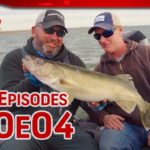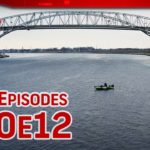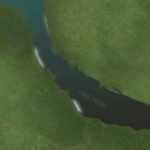Fall Walleyes on Big Waters
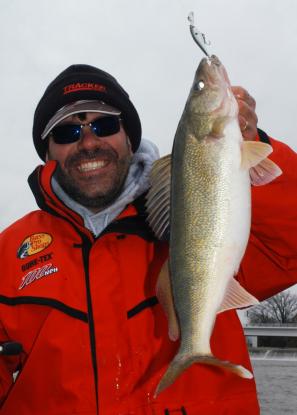 There are a lot of good reasons to love fall walleye fishing, not the least of which is the fact that once the first signs of frost appear on the pumpkin patch, most walleye anglers call it quits for the season. At least that tends to hold true in most areas. Most, except for Lake Erie and many other Great Lakes fisheries! This is the time for the “hard-cores”, warm clothes and bruiser sized walleyes. That’s why we so often schedule TV and video shoots on “Big Water” in the fall … to capture on video, the excitement of landing numbers of big walleyes from the chilling waters of The Great Lakes.
There are a lot of good reasons to love fall walleye fishing, not the least of which is the fact that once the first signs of frost appear on the pumpkin patch, most walleye anglers call it quits for the season. At least that tends to hold true in most areas. Most, except for Lake Erie and many other Great Lakes fisheries! This is the time for the “hard-cores”, warm clothes and bruiser sized walleyes. That’s why we so often schedule TV and video shoots on “Big Water” in the fall … to capture on video, the excitement of landing numbers of big walleyes from the chilling waters of The Great Lakes.
Whether you fish Lake Erie or one of the other popular Great Lakes walleye fisheries, there are two major patterns that typically develop this time of year … a daytime bite on cranks, and a night time bite on cranks. Like anything in fishing, there are no guarantees for success, but if you’re looking to wrap up your year with some memorable catches, this could be your best bet for some truly great fishing trips before hanging up the trolling gear until next season.
The day-time bite is always the first order of business. While most summertime Erie open-water fishing involves runs of 20 miles or more out into the lake, these fall fish are much closer (at least in Erie terms), cruising the basin 4 to 5 miles off shore. Weather patterns can be a big factor in where you’ll find these fish. If warm temps in the early fall have been the norm, and water temps are above 50 degrees, the walleyes should be suspended. If the opposite has been true … water temps dipping below 50 degrees … look for the fish to be relating to the bottom. Don’t get caught going by what the calendar tells you, we’ve fished Erie as late as early December and found the walleyes suspended, 20 to 25 feet down over 40 to 50 feet of water.
In fall it’s typical for the walleyes to roam in small packs rather than huge schools, making it especially important to rely on your electronics to find the fish before setting up on them. The beauty of suspended fish is that they are usually pretty easy to spot on most locators. However, searching for these walleyes in the vast waters of Lake Erie can be time consuming when you’re cruising along at five to six miles per hour graphing the water column to spot signs of fish. A locator with high power and resolution like the Lowrance HDS-10 will allow you to perform what we like to call “Speed Searching”. With a big, easy to read 600 x 800 pixel color display the HDS-10 can mark fish and subtle structure while covering water at speeds as high as 25 mph. That saves you as an angler a lot of valuable fishing time.
GPS is another invaluable tool for fishing these large walleye waters, which is another reason the HDS-10 and similar “sonar/GPS Combo Units” are top choices among Great Lakes anglers. One drawback to combo units in the past has been the fact that when put in split-screen mode to view both sonar and GPS, the displays were so small it made viewing a challenge. With the HDS-10’s huge 10.4 inch diagonal display screen however, there’s plenty of room to view both without straining your eyes. GPS is important because it allows the angler to put out an icon (electronic buoy marker) when pods of fish are located, and by monitoring the plot trail, make precise, effective trolling passes through the school of fish. Most trolling passes will cover 1/4 to 1/2 mile areas at most, unlike the long trolling passes often associated with summer patterns on the Great Lakes.
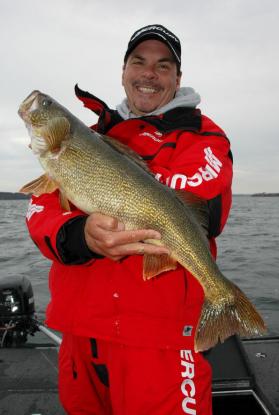 Although fishing can be great, these are not suicidal walleyes. It takes the right presentation to boat these brutes consistently. You need to cover water efficiently, so spreading your trolling program out is a must. In-line boards like Off Shore Tackle’s OR-12 or OR-31 Side Planers are essential to get the baits well out to the sides of the boat. These boards are ideally suited for walleye trolling because they’re ballasted for perfect balance, making them suitable for a wide range of trolling speeds, particularly the slower range speeds (.75 to 1.5 mph) needed to trigger walleyes in cooler water temps. This feature also makes them good trackers in heavier seas which is a big plus when fishing big water in the fall.
Although fishing can be great, these are not suicidal walleyes. It takes the right presentation to boat these brutes consistently. You need to cover water efficiently, so spreading your trolling program out is a must. In-line boards like Off Shore Tackle’s OR-12 or OR-31 Side Planers are essential to get the baits well out to the sides of the boat. These boards are ideally suited for walleye trolling because they’re ballasted for perfect balance, making them suitable for a wide range of trolling speeds, particularly the slower range speeds (.75 to 1.5 mph) needed to trigger walleyes in cooler water temps. This feature also makes them good trackers in heavier seas which is a big plus when fishing big water in the fall.
Top lure choices would lean toward big-lipped, big profiled crankbaits. Remember to troll ‘em slow … 1 to 1.5 mph is ideal for triggering these cool water walleyes.
When the sun goes down on these late season fish, the pattern takes a different turn. The walleyes begin moving in from the basin to feed along the transition break where the soft basin turns to rock, usually around the 20 foot mark. Here you’re only 1/2 to 1 mile off shore, and the fishing can be dynamite! Larger shallow running stickbaits become the lures of choice. Start off running the baits in the 6 to 8 foot range. As in the day, the fish are suspended and spooky, so boards are essential.
While the fall bite on most Great Lakes fisheries usually begins in October, the closer it gets to “ice-up” the better the fishing gets for the bigger fish every walleye angler dreams about. For those willing to brave the icy conditions, it’s a bonanza of monster walleyes few fishermen will ever experience. It comes with a price however. You have to respect the Big Water, especially this time of year. Open water fishing can be rough enough in warm weather, but when you start fishing here in the cold weather time of year it demands some special precautions. This is no place for a small walleye boat … the seas can kick up big in a hurry, so larger boats, in the 19 foot plus range are important. Boats in this class are simply better suited to handle operating in big water, and safety is a key concern particularly when fishing these waters this time of year.
Quality water-proof, cold-weather clothing is also a must. If you get wet, you’re going to suffer … and that will quickly put an end to your fun fishing trip. Layer to stay warm and dry with good long johns, heavy insulated coats and pants, and top-of-the-line rain gear like Bass Pro Shops 100 MPH suits to shed off the cold and water.
If you’re looking for a fall hunting trip of a different kind … don’t be so quick to put the boat away for the season. Hunt up some big Great Lakes walleyes to heat up your late season.


